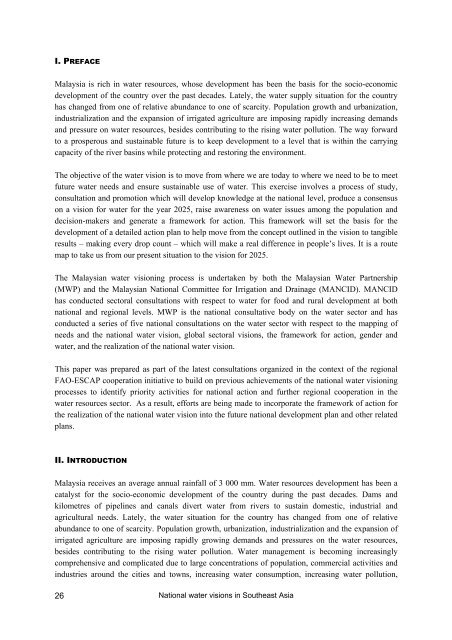The FAO-ESCAP pilot project on national water visions. From vision ...
The FAO-ESCAP pilot project on national water visions. From vision ...
The FAO-ESCAP pilot project on national water visions. From vision ...
You also want an ePaper? Increase the reach of your titles
YUMPU automatically turns print PDFs into web optimized ePapers that Google loves.
I. PREFACE<br />
Malaysia is rich in <strong>water</strong> resources, whose development has been the basis for the socio-ec<strong>on</strong>omic<br />
development of the country over the past decades. Lately, the <strong>water</strong> supply situati<strong>on</strong> for the country<br />
has changed from <strong>on</strong>e of relative abundance to <strong>on</strong>e of scarcity. Populati<strong>on</strong> growth and urbanizati<strong>on</strong>,<br />
industrializati<strong>on</strong> and the expansi<strong>on</strong> of irrigated agriculture are imposing rapidly increasing demands<br />
and pressure <strong>on</strong> <strong>water</strong> resources, besides c<strong>on</strong>tributing to the rising <strong>water</strong> polluti<strong>on</strong>. <str<strong>on</strong>g>The</str<strong>on</strong>g> way forward<br />
to a prosperous and sustainable future is to keep development to a level that is within the carrying<br />
capacity of the river basins while protecting and restoring the envir<strong>on</strong>ment.<br />
<str<strong>on</strong>g>The</str<strong>on</strong>g> objective of the <strong>water</strong> visi<strong>on</strong> is to move from where we are today to where we need to be to meet<br />
future <strong>water</strong> needs and ensure sustainable use of <strong>water</strong>. This exercise involves a process of study,<br />
c<strong>on</strong>sultati<strong>on</strong> and promoti<strong>on</strong> which will develop knowledge at the nati<strong>on</strong>al level, produce a c<strong>on</strong>sensus<br />
<strong>on</strong> a visi<strong>on</strong> for <strong>water</strong> for the year 2025, raise awareness <strong>on</strong> <strong>water</strong> issues am<strong>on</strong>g the populati<strong>on</strong> and<br />
decisi<strong>on</strong>-makers and generate a framework for acti<strong>on</strong>. This framework will set the basis for the<br />
development of a detailed acti<strong>on</strong> plan to help move from the c<strong>on</strong>cept outlined in the visi<strong>on</strong> to tangible<br />
results – making every drop count – which will make a real difference in people’s lives. It is a route<br />
map to take us from our present situati<strong>on</strong> to the visi<strong>on</strong> for 2025.<br />
<str<strong>on</strong>g>The</str<strong>on</strong>g> Malaysian <strong>water</strong> visi<strong>on</strong>ing process is undertaken by both the Malaysian Water Partnership<br />
(MWP) and the Malaysian Nati<strong>on</strong>al Committee for Irrigati<strong>on</strong> and Drainage (MANCID). MANCID<br />
has c<strong>on</strong>ducted sectoral c<strong>on</strong>sultati<strong>on</strong>s with respect to <strong>water</strong> for food and rural development at both<br />
nati<strong>on</strong>al and regi<strong>on</strong>al levels. MWP is the nati<strong>on</strong>al c<strong>on</strong>sultative body <strong>on</strong> the <strong>water</strong> sector and has<br />
c<strong>on</strong>ducted a series of five nati<strong>on</strong>al c<strong>on</strong>sultati<strong>on</strong>s <strong>on</strong> the <strong>water</strong> sector with respect to the mapping of<br />
needs and the nati<strong>on</strong>al <strong>water</strong> visi<strong>on</strong>, global sectoral visi<strong>on</strong>s, the framework for acti<strong>on</strong>, gender and<br />
<strong>water</strong>, and the realizati<strong>on</strong> of the nati<strong>on</strong>al <strong>water</strong> visi<strong>on</strong>.<br />
This paper was prepared as part of the latest c<strong>on</strong>sultati<strong>on</strong>s organized in the c<strong>on</strong>text of the regi<strong>on</strong>al<br />
<str<strong>on</strong>g>FAO</str<strong>on</strong>g>-<str<strong>on</strong>g>ESCAP</str<strong>on</strong>g> cooperati<strong>on</strong> initiative to build <strong>on</strong> previous achievements of the nati<strong>on</strong>al <strong>water</strong> visi<strong>on</strong>ing<br />
processes to identify priority activities for nati<strong>on</strong>al acti<strong>on</strong> and further regi<strong>on</strong>al cooperati<strong>on</strong> in the<br />
<strong>water</strong> resources sector. As a result, efforts are being made to incorporate the framework of acti<strong>on</strong> for<br />
the realizati<strong>on</strong> of the nati<strong>on</strong>al <strong>water</strong> visi<strong>on</strong> into the future nati<strong>on</strong>al development plan and other related<br />
plans.<br />
II. INTRODUCTION<br />
Malaysia receives an average annual rainfall of 3 000 mm. Water resources development has been a<br />
catalyst for the socio-ec<strong>on</strong>omic development of the country during the past decades. Dams and<br />
kilometres of pipelines and canals divert <strong>water</strong> from rivers to sustain domestic, industrial and<br />
agricultural needs. Lately, the <strong>water</strong> situati<strong>on</strong> for the country has changed from <strong>on</strong>e of relative<br />
abundance to <strong>on</strong>e of scarcity. Populati<strong>on</strong> growth, urbanizati<strong>on</strong>, industrializati<strong>on</strong> and the expansi<strong>on</strong> of<br />
irrigated agriculture are imposing rapidly growing demands and pressures <strong>on</strong> the <strong>water</strong> resources,<br />
besides c<strong>on</strong>tributing to the rising <strong>water</strong> polluti<strong>on</strong>. Water management is becoming increasingly<br />
comprehensive and complicated due to large c<strong>on</strong>centrati<strong>on</strong>s of populati<strong>on</strong>, commercial activities and<br />
industries around the cities and towns, increasing <strong>water</strong> c<strong>on</strong>sumpti<strong>on</strong>, increasing <strong>water</strong> polluti<strong>on</strong>,<br />
26<br />
Nati<strong>on</strong>al <strong>water</strong> visi<strong>on</strong>s in Southeast Asia
















